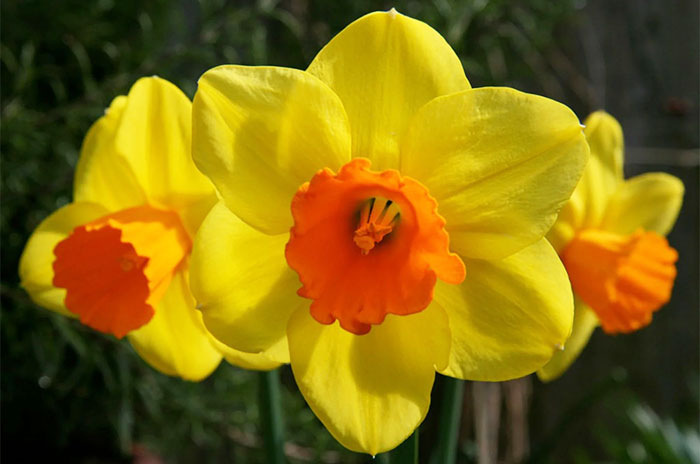Daffodil Flower Symbolism Facts & Meaning: Zodiac, Superstitions, Dreams, and Legends
I
Daffodil Flower Facts
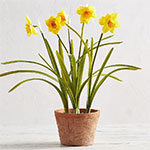
Daffodil Flowers are bright beautiful perennial blooms that can last for decades. This flower has several monickers: Daffodil is its common name, narcissus is its genus, and jonquil is a species name from the narcissus genus. They belong to the amaryllis family, Amaryllidaceae.
Originating in Europe, Daffodils are now found all around the world at these times, thriving in places with temperate climates. The Daffodil is easily recognizable for its bell-shaped center bulb with five to six linear petals growing outward. Due to its popularity, there are many cultivated varieties of Daffodils including the classic yellow. Other colors include white, orange, and even pink. Daffodils also come in different shapes called trumpets, split cups, doubles, jonquils, and large cups.
Daffodils are great springtime flowers that are sure to bloom every year. As long as there is sun and the soil isn’t soggy, Daffodils will thrive. They are quick to multiply and are avoided by pests and deer because of their poisonous properties. This makes Daffodils great border flowers.
Another interesting fact about the Daffodil, it is not recommended to put them in a vase with other flowers because its stem releases latex.
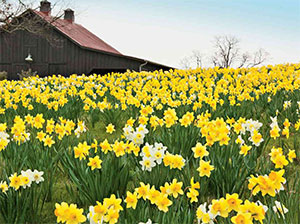
II
Daffodil Flower Uses
Despite being poisonous, Daffodils have a long and well-documented use in folk and traditional medicine. The Romans once believed that Daffodil sap can heal wounds and numb pain. This is false as Daffodil sap will just irritate the wound because it contains crystals of calcium oxalate. Daffodil extracts are documented to cause hallucinations, numbness, convulsions, and chest pains. Despite all these negative symptoms Daffodils had been used as a cancer treatment for centuries.
On a brighter note, modern medicine can extract an alkaloid called Galantamine from Daffodils which are used to treat the early stages of Alzheimer’s.
The main use of Daffodils is to brighten up the garden each spring. The flowers can also be used to make perfume. Daffodils are the first flowers to bloom when spring arrives, making them a great source of pollen for bees and other pollinators. They make beautiful ornamental flowers when planted on flower beds, pots, borders, and practically anywhere.
Lastly, planting Daffodils help in storing nutrients in the soil and making it more fertile. This happens as the Daffodils bloom, they store their nutrients in their bulbs beneath the ground. The stored nutrients are released when the Daffodils die, distributing them to nearby plants that need the extra nourishment.
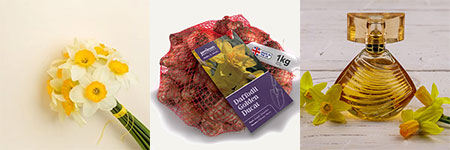
III
Daffodil Flower History
Daffodils originated in Europe. However, the wild variety of Daffodils can be found in different habitats ranging from Northern Europe to North Africa. It is theorized that Daffodils are most likely from Spain and Portugal as these two countries have the most variety of Daffodils.
Daffodils were first documented as garden flowers in 300 BC in Theoprastus’ nine-volume “Enquiry into Plants”. Theoprastus was a Greek botanist and philosopher who documented the many known varieties of narcissus during his time in his book.
The springtime flowers greatly inspired works of art and literature since ancient times. The Daffodil’s genus Narcissus got its name from the ancient Greek mythical figure, Narcissus. The Romans brought the flowers to Britain and planted narcissus on Roman graves. Today, Britain is the world’s top producer of Daffodils.
With thousands of cultivated varieties developed through the centuries, Daffodils are incredibly popular flowers that still inspire artists and writers to this day.
IV
Daffodil Flower Positive Symbolism
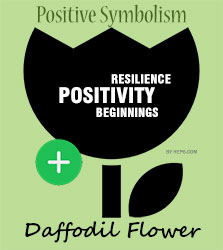
Being one of the first flowers to bloom at the end of winter, Daffodils are associated with the beginning of spring. Hence, it means new beginnings and it is the birth flower of March. In general, Daffodils with their bright colors symbolize sunny days ahead and positivity.
Daffodils are also traditionally associated with the milestone of a 10-year wedding anniversary. The bright flowers symbolize the couple’s resilience and brighter days to come.
V
Daffodil Flower Negative Symbolism
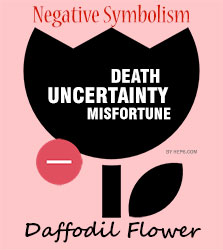
On the flip side, Daffodils also negatively symbolize unrequited love and uncertainty. When one is given a single Daffodil, it negatively means that one means to bring misfortune.
A run-off from ancient beliefs is that Daffodils are a symbol of death as they are often put on graves as a tribute to the dead.
VI
Daffodil Flower Cultural Symbolism
The beauty and striking color of the Daffodil earned it to be a symbol in different cultures around the world. In Greece, it is associated with self-love. In Japan, Daffodils symbolize joy and mirth. Whereas, in China where Daffodils bloom around the Chinese New Year, it is a symbol of good fortune and prosperity. The Daffodil is also the national flower of Wales. In France, Daffodils are signs of hope.
VII
Daffodil Flower Zodiac Sign

Among all the zodiacs, Daffodils are commonly associated with Aries. The Daffodil’s bright colors and symbolism of cheer and mirth perfectly match Aries’ general deposition towards cheer and positivity.
Aries leads the start of the zodiac calendar and Daffodils symbolize new beginnings, and both represent the month of March. Furthermore, Aries are uncomplicated and passionately loyal, similar to the Daffodil easy upkeep and reliable bloom each year.
VIII
Daffodil Flower in Dreams
Most dream interpretations of Daffodils are positive. For single individuals who dreamt of Daffodils, it means that they will meet and marry a beautiful partner. Other interpretations include good fertility, receiving good news in life, or a new chapter in life. Dreaming of Daffodils also means being perceived as beautiful by others but not to be vain or narcissistic.
IX
Daffodil Flower Omens and Superstitions
There are different superstitions about Daffodils among different cultures. In the middle east, Daffodils are considered to be aphrodisiacs. Other regions view them as good luck charms and wear them on their clothing. Also, bringing a bunch of Daffodils into a home gives good luck to the homeowner. In Wales, finding the first wild Daffodil in bloom will receive good fortune.
There are also negative superstitions associated with Daffodils. Having a single Daffodil will bring bad luck. If Daffodils are brought inside where there are hatching geese or chicks, no birds will survive.
X
Daffodil Flower Mythology and Folklore
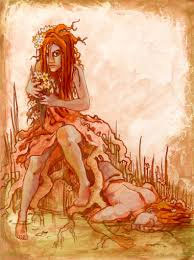
The Greek myth of Narcissus and Echo tells the story of how Daffodils (known then as narcissus) came to be. The myth goes that the nymph, Echo, was pursuing a handsome hunter, Narcissus. Fleeing from Echo’s advances, Narcissus stumbled upon a pond and saw his reflection. He was enamored and refused to look away day and night until he died. Where Narcissus’s body lay, the first Daffodil Flowers came to bloom.
Another Greek myth was the Abduction of Persephone. Persephone, daughter of Demeter, was picking Daffodils and violets, when Hades, god of the underworld, abducted her to make her his bride and queen of the underworld.

